 Une cible M6 accrochée sous le ventre d'un MiG-23UB tchécoslovaque paré pour une mission au-dessus de la Baltique.
D'un diamètre de 28 cm, elle mesurait un peu plus d'un mètre de long et pesait 98 kg. © S.Rogl.
Une cible M6 accrochée sous le ventre d'un MiG-23UB tchécoslovaque paré pour une mission au-dessus de la Baltique.
D'un diamètre de 28 cm, elle mesurait un peu plus d'un mètre de long et pesait 98 kg. © S.Rogl.
A M6 target under the belly of a Czechoslovak AF MiG-23UB ready for a new mission over the Baltic Sea.
It was a little bit more than one meter long with a diameter of 28 cm. The weight was 98 kg. © S.Rogl.
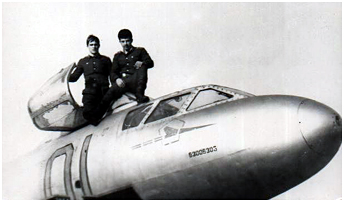 However, the Il-28s were not necessarily required for air-to-air gunnery.
The dedicated targets could be carried indeed by the fighters themselves as well. Two types of targets could be used, both externally looking like weapons!
They could be M6 chute-retarded targets, which had the appearance of a 100-kg bomb with very small fins. An Il-28 without winch could
carry up to ten targets inside its bomb bay and two underwing as well. Once released, they descended slowly - 3 to 15 meters per second or 11-54 km/h -
hanging under a 36 m² parachute. The body of the target was a burning heat source that generated a 2 million candle-power
infrared signature,
providing a target for missiles equipped with an IR heat-seeking head. Launched from an altitude between 2500 and 17,000 meters - western radio
intercept reports mentioned Il-28s delivering a target from 12,000 meters - at a speed of 750 to 1200 km/h, the M6 could burn for a minimum of 195 seconds.
This target was also designed to attract radar-guided missiles: a reflector net and a metallic body with a radar signature similar to that of a medium bomber
were indeed attached under the parachute dome. A MiG-21 radar could "see" the target at 20 km and a R-3S missile could be fired from a range
of 5-8 km.
However, the Il-28s were not necessarily required for air-to-air gunnery.
The dedicated targets could be carried indeed by the fighters themselves as well. Two types of targets could be used, both externally looking like weapons!
They could be M6 chute-retarded targets, which had the appearance of a 100-kg bomb with very small fins. An Il-28 without winch could
carry up to ten targets inside its bomb bay and two underwing as well. Once released, they descended slowly - 3 to 15 meters per second or 11-54 km/h -
hanging under a 36 m² parachute. The body of the target was a burning heat source that generated a 2 million candle-power
infrared signature,
providing a target for missiles equipped with an IR heat-seeking head. Launched from an altitude between 2500 and 17,000 meters - western radio
intercept reports mentioned Il-28s delivering a target from 12,000 meters - at a speed of 750 to 1200 km/h, the M6 could burn for a minimum of 195 seconds.
This target was also designed to attract radar-guided missiles: a reflector net and a metallic body with a radar signature similar to that of a medium bomber
were indeed attached under the parachute dome. A MiG-21 radar could "see" the target at 20 km and a R-3S missile could be fired from a range
of 5-8 km.
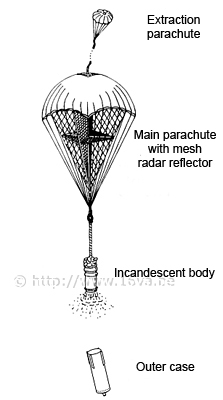
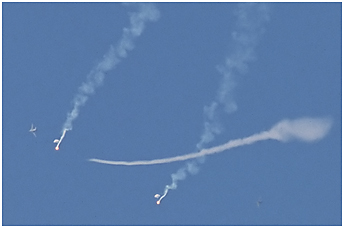 Incidentally, another target model made the headlines on 24 August 1990 when apparently stationary luminous spheres were spotted
in the skies in the Greifswald area above the sea and filmed by many people. They even saw a smaller sphere flying towards the main
formation and disappear just before reaching it...
Well, it was nothing other than a missile flying to its target and running
out of fuel just before reaching it, apparently without exploding!
If ufologists want to continue to believe in paranormal phenomena, during an interview given to a German television network some years later,
General Tarasenko himself explained what happened that night
(the targets and the missile can be seen here:
upload 1
- upload 2). Analyses of these observations
(see link 3) revealed that the area where
those 'UFOs' appeared was situated at the southern edge of the air-to-air range - used by the Czechoslovak
Air Force on that day (who probably had, on that occasion, the honor to perform the very last firing session on that range).
Incidentally, another target model made the headlines on 24 August 1990 when apparently stationary luminous spheres were spotted
in the skies in the Greifswald area above the sea and filmed by many people. They even saw a smaller sphere flying towards the main
formation and disappear just before reaching it...
Well, it was nothing other than a missile flying to its target and running
out of fuel just before reaching it, apparently without exploding!
If ufologists want to continue to believe in paranormal phenomena, during an interview given to a German television network some years later,
General Tarasenko himself explained what happened that night
(the targets and the missile can be seen here:
upload 1
- upload 2). Analyses of these observations
(see link 3) revealed that the area where
those 'UFOs' appeared was situated at the southern edge of the air-to-air range - used by the Czechoslovak
Air Force on that day (who probably had, on that occasion, the honor to perform the very last firing session on that range).
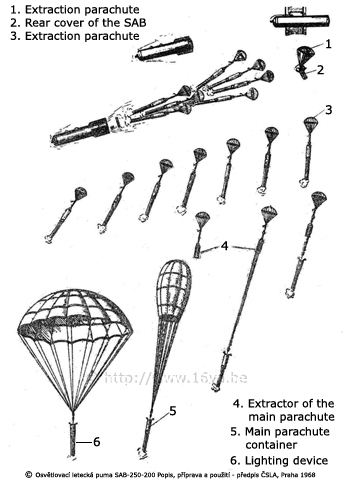 However, careful observation of videos filmed at that time seem to show that flare bombs (SAB, Svetyashchaya Aviatsionnaya Bomba - flash bomb)
were used instead of traditional targets. SAB were designed to illuminate the ground during night bombing.
The bombs used as targets could have been SAB-100MN/MP models (the latter used the same outer case as the M6 target), SAB-250-200, SAB-250T or SAB-500-350.
However, careful observation of videos filmed at that time seem to show that flare bombs (SAB, Svetyashchaya Aviatsionnaya Bomba - flash bomb)
were used instead of traditional targets. SAB were designed to illuminate the ground during night bombing.
The bombs used as targets could have been SAB-100MN/MP models (the latter used the same outer case as the M6 target), SAB-250-200, SAB-250T or SAB-500-350.
 A l'avant-plan, une torche et son parachute provenant d'une bombe SAB-250-200, celle d'une SAB-100MN en arrière-plan et enfin celle d'une bombe
SAB-250T au centre. © "Secrets of the Soviet Airbase" museum, Berekfürdo, Hungary - www.soviet-airforce.com
A l'avant-plan, une torche et son parachute provenant d'une bombe SAB-250-200, celle d'une SAB-100MN en arrière-plan et enfin celle d'une bombe
SAB-250T au centre. © "Secrets of the Soviet Airbase" museum, Berekfürdo, Hungary - www.soviet-airforce.com
A torch and its parachute from a SAB-250-200 flare bomb in the foreground, one from a SAB-100MN in the background and finally,
one from a SAB-250T between them. © "Secrets of the Soviet Airbase" museum, Berekfürdo, Hungary - www.soviet-airforce.com
Once a bomb had been dropped, it released seven flares that descended under an individual parachute (see
diagram at left). The deployment of the flares followed this chronology: when the bomb was dropped,
a mechanical or electronic system lit a cordite charge after a few seconds in order to eject the rear cover of the bomb.
A small extraction parachute deployed at the same time behind the rear cover facilitated the process. The latter triggered the opening of the flare extraction
parachutes during its ejection.
The flares already had been lit automatically when the rear cover of the bomb detached.
The flare extraction parachutes then gradually deployed the main parachutes of the latter, which burned for five minutes.
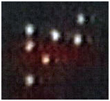 L'inexpliquable expliqué ! Les sept torches d'une bombe éclairante SAB le 24 août 1990 au-dessus du polygone de tir air-air de la 16.VA.
L'inexpliquable expliqué ! Les sept torches d'une bombe éclairante SAB le 24 août 1990 au-dessus du polygone de tir air-air de la 16.VA.
The unexplainable explained! The seven torches of a SAB flare bomb on August 24, 1990 over of the air-to-air firing range of the 16.VA.
But why did the Czechs use these bombs - apparently easier to "shoot down" by IR missiles because they comprised several heat sources -
rather than dedicated targets? In fact, using SAB-100 and SAB-250 flare bombs as targets seemed to be a widespread practice also enforced
among the target towing squadrons based at Damgarten. (1).
Another target used was the RM-3V (Raketa-Mishen, target missile), derived from the Vympel' K-13 (AA-2 "Atoll") missile. Fighter aircraft carried either
combat-ready missiles or R-3P (Prakticheskaya, practise) missiles without warhead. The leader first fired an RM-3V, while his wingman shot it down. The process
was then reversed: the wingman fired another RM-3V, and the commander fired a missile against it. It was possible to launch a missile up to 25 seconds after launching an RM-3V.
| A dream assignment |
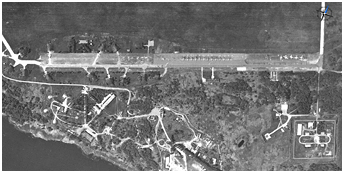
 During the summer of 1986, Pilot First Class Oleg Kozlov ferried an Il-28 "Beagle" from the 65.OBAE to Altes Lager
to serve as an instructional airframe (2).
In November, the unit's remaining "Beagle" aircraft were withdrawn from use and replaced by 12 MiG-23M and UB. The choice of the latter
aircraft type was probably an improvised solution before introduction of a more specialized airframe for
the task. The origin of these aircraft remains questionable. At most, we can state that a derelict MiG-23M originating from the 35.APIB
of Zerbst was present in the Damgarten dump in 1992. Also, in November 1986, the 74.OBAE was disbanded. The 65.OBAE composition changed
with the Floggers arrival. It was then composed of two aviation flights (aviazveno) and a third separate flight (the 125.OBAZ)
composed of former 74.OBAE elements.
The MiG-23M did not tow targets. Instead, they launched M6 targets (that was the case to train the sailors at Swinoujscie),
glide bombs (probably PM-6 targets) and S-5P chaff rockets - the chaff created a radar echo that could be used as a target - fired from
classic UB-32 rocket pods. Also, the MiG-23 were only used as "reflecting" targets (3) at Wustrow.
During the summer of 1986, Pilot First Class Oleg Kozlov ferried an Il-28 "Beagle" from the 65.OBAE to Altes Lager
to serve as an instructional airframe (2).
In November, the unit's remaining "Beagle" aircraft were withdrawn from use and replaced by 12 MiG-23M and UB. The choice of the latter
aircraft type was probably an improvised solution before introduction of a more specialized airframe for
the task. The origin of these aircraft remains questionable. At most, we can state that a derelict MiG-23M originating from the 35.APIB
of Zerbst was present in the Damgarten dump in 1992. Also, in November 1986, the 74.OBAE was disbanded. The 65.OBAE composition changed
with the Floggers arrival. It was then composed of two aviation flights (aviazveno) and a third separate flight (the 125.OBAZ)
composed of former 74.OBAE elements.
The MiG-23M did not tow targets. Instead, they launched M6 targets (that was the case to train the sailors at Swinoujscie),
glide bombs (probably PM-6 targets) and S-5P chaff rockets - the chaff created a radar echo that could be used as a target - fired from
classic UB-32 rocket pods. Also, the MiG-23 were only used as "reflecting" targets (3) at Wustrow.
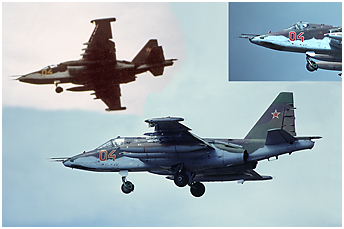
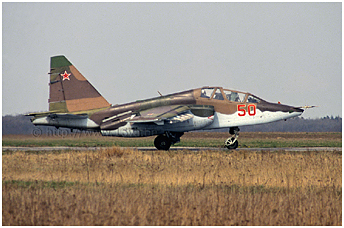 The MiG-23M of the 65.OBAE did not last long. They were withdrawn in November 1989 when the aircraft were flown to and stored at Step'
Airbase (Olovyannaya) in the Transbaykal.
On November 25, 1989 two Su-25 of the 357.OShAP from Brandis joined the 65.OBAE so that the pilots could train on this new airframe.
In addition, a new Su-25UB (n°50) two-seat trainer was delivered from Ulan-Ude to Damgarten in April 1990. In early May 1990,
the 65.OBAE received ten new Su-25BM ground-attack and target-towing aircraft with yellow numbers from Tbilisi in Georgia (n° 01-06 / 08-11)
(see > Ground-Attack Aviation, part 9).
The Su-25UB remained on strength with the unit, while the two Su-25 from Brandis were sent to Ovruch in Ukraine for storage.
Target towing was not resumed with the Su-25BM, because the new Kometa target-towing system was still in the testing phase, which was not completed until October 1991.
The Su-25BM could nevertheles carry M6 and PM-6 targets. It should be noted that L-39C were also observed at Damgarten alongside the Su-25BM. However,
we do not know whether these planes were attached to the 65.OBAE or detached from the 368.OShAP from Demmin. Also, two new Su-25BM then joined
the 368.OShAP by the end of July 1990 at the latest. Contrary to normal practice, they were delivered without bort numbers and were assigned
the numbers 16 and 17.
In October 1990, the 65.OBAE aircraft were redeployed to Demmin and squadron personnel were divided up between the 357.OShAP and the
fourth squadron of the 368.OShAP (4). The 65.OBAE thus was immediately disbanded
thereafter on November 1, 1990. The yellow bort numbers on the planes were then painted red
(and sometimes changed) to bring them in line with those of the 368.OShAP. The 12 Su-25BM were assigned to the 1.AE, while 16 Su-25 were transfered to the 357.OShAP at Brandis
where they likely replaced the aircraft with the least remaining service life.
The MiG-23M of the 65.OBAE did not last long. They were withdrawn in November 1989 when the aircraft were flown to and stored at Step'
Airbase (Olovyannaya) in the Transbaykal.
On November 25, 1989 two Su-25 of the 357.OShAP from Brandis joined the 65.OBAE so that the pilots could train on this new airframe.
In addition, a new Su-25UB (n°50) two-seat trainer was delivered from Ulan-Ude to Damgarten in April 1990. In early May 1990,
the 65.OBAE received ten new Su-25BM ground-attack and target-towing aircraft with yellow numbers from Tbilisi in Georgia (n° 01-06 / 08-11)
(see > Ground-Attack Aviation, part 9).
The Su-25UB remained on strength with the unit, while the two Su-25 from Brandis were sent to Ovruch in Ukraine for storage.
Target towing was not resumed with the Su-25BM, because the new Kometa target-towing system was still in the testing phase, which was not completed until October 1991.
The Su-25BM could nevertheles carry M6 and PM-6 targets. It should be noted that L-39C were also observed at Damgarten alongside the Su-25BM. However,
we do not know whether these planes were attached to the 65.OBAE or detached from the 368.OShAP from Demmin. Also, two new Su-25BM then joined
the 368.OShAP by the end of July 1990 at the latest. Contrary to normal practice, they were delivered without bort numbers and were assigned
the numbers 16 and 17.
In October 1990, the 65.OBAE aircraft were redeployed to Demmin and squadron personnel were divided up between the 357.OShAP and the
fourth squadron of the 368.OShAP (4). The 65.OBAE thus was immediately disbanded
thereafter on November 1, 1990. The yellow bort numbers on the planes were then painted red
(and sometimes changed) to bring them in line with those of the 368.OShAP. The 12 Su-25BM were assigned to the 1.AE, while 16 Su-25 were transfered to the 357.OShAP at Brandis
where they likely replaced the aircraft with the least remaining service life.
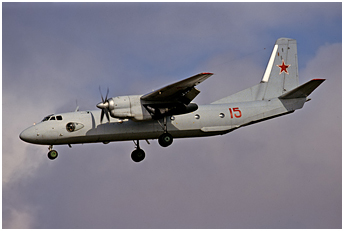
|
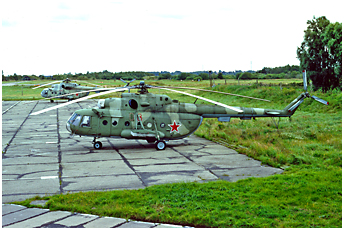
|
With special thanks to Oleg Kozlov for his unstinting help
 |
Su-25 ex-65.OBAE PHOTO PAGE |  |
 |
Il-28 WRECKS PHOTO PAGE |  |
notes
(1) In April 2012, SAB-250T and SAB-250-200 flare bombs carried by Su-27s were used as targets during exercise "Ladoga-2012".
These bombs also caused a stir similar to the Greifswald case (especially in forums dedicated to UFOs where most contributors persist beyond all reason to believe
in their chimera) when inhabitants of St. Petersburg observed and filmed them at night while they were descending far away above Lake Ladoga!
It is therefore clear that the use of flare bombs as targets during air-to-air missile firing exercises was not unusual.
(2)
Different solitary Il-28s have been observed on several bases over time. Some were used for battle damage repair training.
(3)
The target aircraft was detected by the firing unit radar. A second radar repeated this radar echo
of the target with different coordinates. It is towards this second fictive or mirror echo that shells or missiles were fired. A special device
permitted to assess whether the target had been hit. Schematic diagram >
HERE.
(4)
Andrey Kozhemyakin, Su-25 specialist and author of a two-volume work entitled "Shturmovik Su-25, In Action for 30 Years" (Shturmovik Su-25, Tridtsat' Let v Stroyu)
told us that, in 1989, many units were disbanded and consequently many pilots found themselves without planes. It was thus decided to set up a fourth squadron in several
regiments, while the number of aircraft in service with these same units remained the same. The excess pilots in the fourth squadrons flew the planes in the three squadrons,
constituting a traditional regiment. It is not certain that an additional squadron was formed within the 357.OShAP at Brandis. However, this was the case at Demmin where,
according to official documents, a fourth squadron was formed in November 1989.
 |
The target-towing units < Part 1 |
 |
Plan du site - Sitemap |  |
